| Article ID | Journal | Published Year | Pages | File Type |
|---|---|---|---|---|
| 3877448 | The Journal of Urology | 2008 | 7 Pages |
PurposeThis review provides a brief update on genetic studies of primary hypercalciuria. We consider their possible implications for the pathogenesis and complications of primary hypercalciuria.Materials and MethodsUsing the PubMed®, MEDLINE® and Scopus® databases we reviewed the literature on pathogenesis and the complications of hypercalciuria, giving particular attention to genetic studies in humans.ResultsPrimary hypercalciuria is a defect occurring in 5% to 10% of the general population and it is most commonly detected in patients with calcium kidney stones or osteoporosis. In children it is associated with hematuria, renal stones or nocturnal enuresis. Although high penetrance, autosomal dominant inheritance cannot be ruled out, hypercalciuria is probably a polygenic disorder. A number of genes have been suggested as candidates in the pathogenesis of common idiopathic calcium nephrolithiasis and hypercalciuria, ie soluble adenylate cyclase, calcium sensing receptor, vitamin D receptor, chloride channel-5, sodium-phosphate cotransporter-2 and claudin-16. These genes may also have a role in complications of hypercalciuria.ConclusionsThe classic distinction among absorptive, renal and resorptive hypercalciuria seems insufficient to explain the many cellular and tissue modifications observed in patients with primary hypercalciuria. The condition seems to be a separate disorder, characterized by altered calcium transport in the intestine, kidney and bone, and caused by various combinations of multiple genetic and dietary changes.
